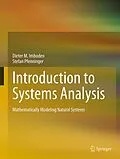This book builds an understanding of what systems are and how they can be described mathematically. In the context of natural science, this knowledge is of great importance. The intended audience are students in applied sciences such as earth and environmental science, geoecology, environmental chemistry and forestry. The focus is on the methods of modeling, with the aim to let readers develop models of their own as well as analyze the properties of models they encounter. Numerous practical examples from the environmental sciences illustrate the concepts, and exercises accompany each chapter. The book is written so as to be easily understandable and includes humorous cartoons. There is no derivation of mathematical formulas or technical description of modeling software. It does, however, require an understanding of calculus for the reader to apply the mathematical methods it introduces.
Autorentext
Dieter Imboden is Professor of Environmental Physics. His research concerns the study of physical processes in aquatic systems as well as problems of energy and climate politics. He is President of the Research Council of the Swiss National Science Foundation (SNSF)
Stefan Pfenninger joined IIASA's Risk, Policy and Vulnerability Program (RPV) in January 2010. He is contributing to RPV's research on resilience, adaptation and renewable energy. Stefan holds a BSc in Environmental Science from ETH Zurich and an MSc in Environmental Technology from Imperial College London.
Klappentext
Systems and their mathematical description play an important role in all branches of science. This book offers an introduction to mathematical modeling techniques. It is intended for undergrad students in applied natural science, in particular earth and environmental science, environmental engineering, as well as ecology, environmental chemistry, chemical engineering, agronomy, and forestry.
The focus is on developing the basic methods of modeling. Students will learn how to build mathematical models of their own, but also how to analyze the properties of existing models. The book neither derives mathematical formulae, nor does it describe modeling software, instead focusing on the fundamental concepts behind mathematical models. A formulary in the appendix summarizes the necessary mathematical knowledge. To support independent learners, numerous examples and problems from various scientific disciplines are provided throughout the book. Thanks in no small part to the cartoons by Nikolas Stürchler, this introduction to the colorful world of modeling is both entertaining and rich in content
Inhalt
1. Introduction.- 2. Mathematical models.- 3. Static models.- 4. Linear one dimensional models.- 5. Linear multi dimensional Models.- 6. Non-linear models.- 7. Time discrete models.- 8. Models in time and space.- A. List of symbols.- B. Dimensions and units.- C. Formulary.- D. Eigenvalues.- E. Time-dependent diffusion equation.- Bibliography.- Index
